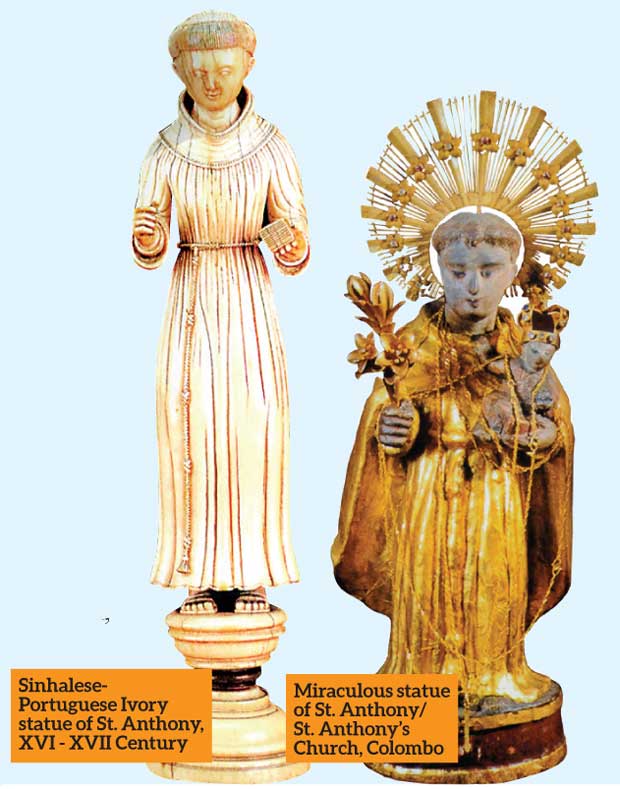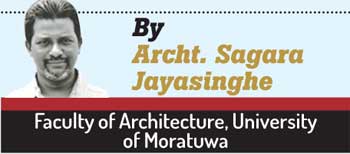Reply To:
Name - Reply Comment
Last Updated : 2024-04-19 21:46:00

The Portuguese missionaries introduced the Catholicism to Sri Lanka in the mid 16th century. Therefore it could be presumed that the devotion to St. Anthony was introduced to our ancestors by the Franciscan missionaries who first arrived in Sri Lanka in 1543.
This presumption is supported in the chronicles of the period of Portuguese expansions, where St. Anthony is identified as the “Portuguese Saint”. It is further supported by the records belonging to the period of Dutch occupation, even though they promulgated a rule to ban Catholicism in the Dutch controlled areas, the devotion to St. Anthony was not getting mitigated among the Catholics in the island. Even today his cult is a popular phenomenon in the Catholic Church in Sri Lanka.
According to the records the Portuguese soldiers that set out to conquer Sri Lanka had implicit faith in St. Anthony. The chronicle of Fernaó de Queyroz,
“The Temporal and spiritual Conquest of Ceylon”, mentions the several incidents which reveal the devotion the Portuguese had for St. Anthony. It is said that in 1564 a military expedition commenced on the eve of 13th June - the saint’s feast day, it consisted of Four companies of Portuguese soldiers, each headed by a captain who bore the name Anthony (Antonio).
“ 100 Portuguese and some Lascarins for the exploit. Laeerda immediately gave up his place at Perea Cota (Kotte) to Antonio Chainho de Castro and set out at night, formed into four companies, of which the other Captains were Antonio Dias do. Lomba, Antonio Morro and Antonio Guerreyra, because  Guedes chose all of the same name. They set out from Cota (Kotte) on the 12th June 1564, the eve of the feast of St. Antony, so that this choice might oblige the Saint not to forget the Portuguese”.
Guedes chose all of the same name. They set out from Cota (Kotte) on the 12th June 1564, the eve of the feast of St. Antony, so that this choice might oblige the Saint not to forget the Portuguese”.
On another occasion, several decades later, the Portuguese were in grave danger within the enemy territory, “seeing that there was no other recourse, they made an act of contrition, taking St Anthony for a guide; to whom they prayed to save them from utter destruction. As soon as they started, there fell such heavy rain that it gave the foe no room to follow them, though they knew of their departure and meant to kill them, which they attributed to a miracle of the Saint.”
It can be perceived that the Portuguese’s devotion to St Anthony is also portrayed in the history of the fortifications in Sri Lanka. The Fort at Galle was originally constructed by the Portuguese at the location of a Franciscan chapel and named it Santa Cruz. Subsequently it was extended to include a watch tower and three bastions. One bastion was named as Sao Antonia is dedicated to St. Anthony. Similarly, the triangular Portuguese fort at Trincomalee is identified in the map as “Planta da fortalesa de Trinquilimale” (1627) has three bastions of which one was named after St. Anthony. Further, a map (1655) gives an image of the Colombo Fort in the Portuguese era.
It was fortified by a ring of twelve bastions with intervening ramparts supported by moats, flanked to the east by a lake and to the west by a boulder. Following the tradition, these twelve bastions were dedicated to saints one of whom St. Anthony.
With the death of King Buvenakabhahu (1521-1551) the newly crowned Dharmapala (1551-1597) was converted to Christianity and was baptized as Dom Joao in the year 1557. In a chapter of his chronicle “Conquista Spiritual Do Oriente” concerning the baptism of Don Joao Dharmapala, Paulo da Trindade, describes “And since they lacked a church where they could hear the word of God and assist at Mass and other divine services, the servants of God made use the famous temple which was there. In this church they taught and they dedicated it to St. Anthony”. It is recorded that in 1565 when city of Kotte was abandoned and with the withdrawal of Franciscans, the Portuguese demolished the church.
When the Franciscans came to Sri Lanka they built a monastery and church in honor of St. Anthony in Colombo. It became the headquarters for their missionary work. This monastery and church has a unique history as it played a significant dogmatic and pedagogical role in the political affairs of the era. The chronological records indicate that when King Don Juan Dharmapala died in 1597, his mortal remains were reposed inside this church. Paulo da Trindade records this occasion;
“That he might no less show his devotion in death, than he had while alive, in the same testament he ordered that his body be clothed in our habit and buried in our church of St. Anthony at Colombo.”
Many royal personages have been baptized in this church. When after the death of Pararajasekaran the ruler of Jaffna, the territory was annexed to the Portuguese command and the members of the royal family were brought to Colombo. It was at the church of St. Anthony in Colombo where his son Constantino, the two daughters Dona Izabel and Dona Maria and other royal personages were baptized in 1623.
It is reported that the Franciscan missionaries built a number of churches in the kingdoms of Kotte and Jaffna which also included some churches named after St. Anthony. These churches were built in villages of Bambarenda and Aluthgama in the kingdom of Kotte and of Kachchei in the kingdom of Jaffna. Franciscan accounts of 1599 on the payments for the maintenance of the friars in charge of the native Christians mention another church of St. Anthony built in the village of Pallansena in the kingdom of Kotte. In addition to that the Franciscans correspondences of 1602 regarding the Christian community administration indicate another two churches of St. Anthony in the villages of Kammala and Weligama.
During the time of the massacres by the Dutch, the Catholics fled the Dutch controlled areas searching for refuge under the patronage of King Rajasinghe II (1635 – 1687) of the Kandyan Kingdom. The village of Wahakotte was one such locality where they sought refuge. A brief description about Wahakotte village is mentioned in the accounts of A. C. Lawrie, who wrote about the island’s North central region in his volume, ‘A Gazeteer of the Central Province of Ceylon’. It is mentioned that the only religious icon of the people who came and settled thus was a small statue of St. Anthony. He describes that “They possessed a small image of St. Anthony, for which they have a great devotion and which they worshipped in secret”. This statement seems to support the view that the statue of St. Anthony was with the people who settled in Wahakotte before the freedom of worship was given by the Kandyan king. There is a popular legend that once the statue was hidden in a boiling pot of rice in order to save it from the Dutch persecutors.
Towards the end of the Dutch occupation, as the numbers of Catholics kept increasing in Colombo Jacome Gonsalvez, the Superior of the Oratorians of Ceylon realized the need for a priest permanently residing there. An Oratorian called Anthony from Cochin, volunteered and left for Colombo. According to a popular legend Anthony performed his duties thus for about a year until, the Dutch raided him on a tip off. Anthony escaped, and left for Mutwal which was predominantly a Catholic area. During this time, sea erosion had narrowed the beach to an extent. The fishermen were anxious for a solution when they met Anthony who was on his way to escape. As a desperate last resort they invited him to offer his prayers to prevent sea erosion.
They assured Anthony that should he succeed, they would give him protection from Dutch soldiers. While he was praying, the waves began to recede and created a retaining sand bank which formed a dam. The amazed fishermen flocked around him while the Dutch soldiers had to retreat.
The Dutch Governor Maurits Bruyninck’s (1739-1742) appointment was significant as it occurred soon after the “Miracle of Anthony”. His liberal attitude towards the Catholics made him to give the plot of land where the “Miracle” took place to Anthony in order to exercise his ministry.
It is significant that this was the first time since year 1656 freedom for the Catholics to perform religious activities within the city of Colombo was granted. Anthony built a small chapel in this plot of land and to show his gratitude and dedicated same to his patron saint St. Anthony.
Later, this plot of land was officially handed over to the church by the Dutch East India Company on the 20th of January 1790, by deed no. 31 which contains the VOC monogram. In the course of time this church developed into a great shrine and today has become the greatest shrine of St. Anthony in Sri Lanka.
Romesh Monday, 13 June 2016 12:50 PM
Today is St. Anthony's day

Add comment
Comments will be edited (grammar, spelling and slang) and authorized at the discretion of Daily Mirror online. The website also has the right not to publish selected comments.
Reply To:
Name - Reply Comment
On March 26, a couple arriving from Thailand was arrested with 88 live animal
According to villagers from Naula-Moragolla out of 105 families 80 can afford
Is the situation in Sri Lanka so grim that locals harbour hope that they coul
A recent post on social media revealed that three purple-faced langurs near t